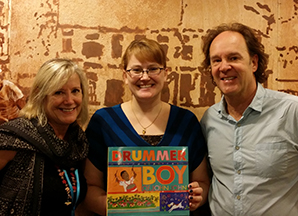Stacy Whitman is Editorial Director and Publisher of Tu Books, an imprint of LEE & LOW BOOKS that publishes diverse science fiction and fantasy for middle grade and young adult readers. Parts of this blog post were originally posted at her blog, Stacy Whitman’s Grimoire.
During the first week of June, I attended the Asian Festival of Children’s Content in Singapore. At the conference, I met writers from all over Asia and the Pacific, discussing craft, marketing their books at home and abroad, and translation. I even ran into Mark Greenwood and Frané Lessac, the Australian author/illustrator team behind the LEE & LOW picture book The Drummer Boy of John John. I enjoyed all the panels and the chance to see Singapore and meet so many people from the other side of the world—it gives you a perspective as an editor you might not otherwise have.
One of the panels I participated in was a First Pages event, in which I read about 20 first pages of picture books, middle grade, and YA novels and then gave feedback on whether the pages were working for me and if I’d want to read more.
For the fantasy and science fiction entries, a common problem was—and is in any new writer’s writing—revealing enough about the world that you create interest and intrigue, but not too much. Too much, and you risk alienating your audience, confusing them, or simply not hooking them. Reader reactions are so subjective. One person might think there’s not nearly enough worldbuilding in a book (“give me more! MORE!”) and another might say of the exact same book that what worldbuilding there is was way too confusing (“I couldn’t keep all those made-up words straight!”).
So how do you, as the author, balance the needs of such a wide range of readers when you’re working in a complex world? And how do you balance the need to establish your characters, setting, and plot with the need to spool out information to your reader to intrigue them rather than confuse them?
This is a question that almost every author and editor of speculative fiction struggles with, particularly because we, as veterans of the genre, are already more comfortable with a lot of jargon than your average teen reader, particularly teen readers whose preference for fantasy runs more toward the contemporary paranormal variety.

Stacy Whitman at the famous Singapore merlion fountain
There are a number of reasons why I think Twilight was so popular on such a broad scale, but one of the biggest ones was the relatability of the initial situation. Not vampires showing up at school—before that. We start with a simple story about a girl who is leaving her mother behind in Arizona to live with her father in an unknown small town on the Olympic Peninsula of Washington. Relatable: divorced parents, fish out of water, adapting to a new school and a new climate.
Think about all the really big fantasy hits of the last decade or so in children’s and YA fiction: Harry Potter, Percy Jackson, Twilight, Hunger Games, Divergent. Of these books’ beginnings, only the dystopian tales start all that far outside the everyday experiences of your average young reader, and even The Hunger Games starts with a relatable situation—a coal mining family lives in a desperate situation and must hunt for food.
While most kids who would have access to The Hunger Games don’t live under a despotic regime, it’s plausible that it could happen in the real world. Every kid has been hungry at some point, though perhaps not as hungry and desperate as Katniss. Every kid has taken a test in school, and sometimes it feels like those standardized tests do determine your everlasting fate, as they do in Divergent, even if Tris’s Abnegation explanations are a little tedious. Harry Potter and Percy Jackson are ordinary kids going to school, living somewhat normal lives (even if abusive ones, in the case of Harry) before their worlds change with the discovery of magic.
There are three primary approaches to worldbuilding:
Reader learns world alongside character
Exposition: questions raised, then answered
“Incluing”: questions raised, then reader infers answers bit by bit
Next Thursday, I’ll go into detail about each of these techniques and give some examples. In the meantime, think about your favorite science fiction and fantasy books. How do they bring you into their world? What works best for you as a reader? Answering these questions about your own reading preferences can help guide you as a writer.











